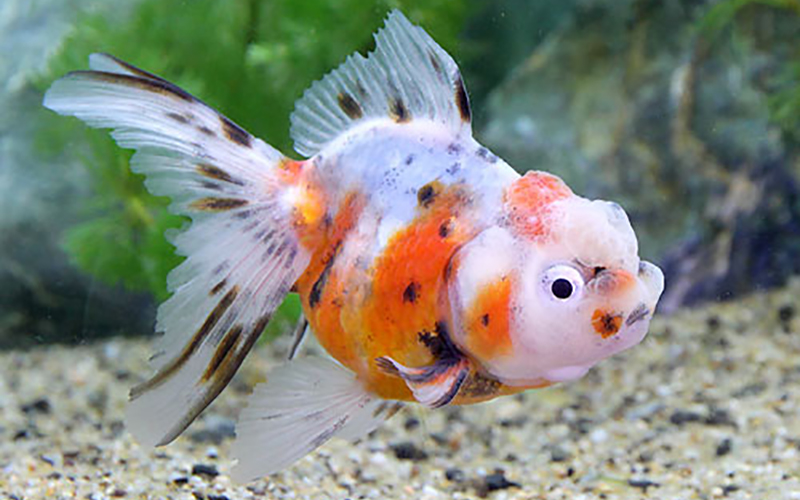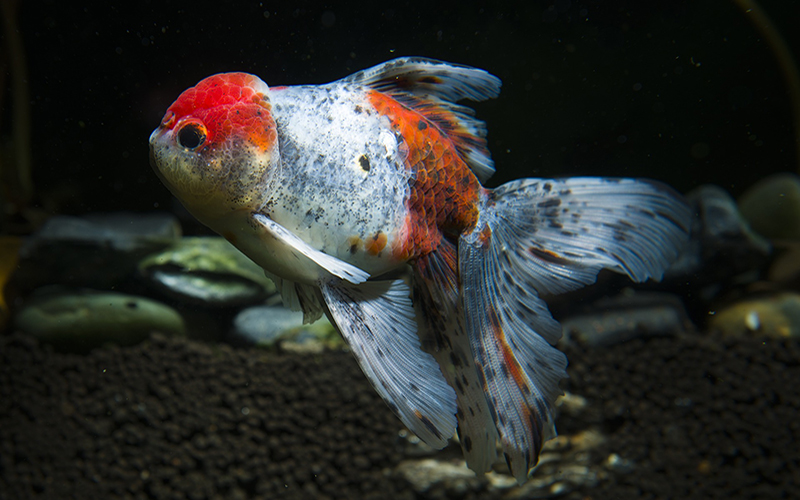ecology
Table of Contents

Azuma Nishiki (Azuma Nishiki) is,The body shape and body form are the same as those of the Japanese lionhead, but the body color is miscellaneous with mosaic transparent scale-like scales like tricolor (calico).The body shape is the same as that of the Woran lion's head, and the mass of flesh on the top of the head, a characteristic of the Woran lion's head, gradually develops as the animal ages. The body color of the Azuma Nishiki is red and pale blue, with black and white in good balance, making it very beautiful.
Higashinishiki is,In 1931, Mr. Kinzo Kato, a goldfish merchant in Yokohama, crossed the Calico demekin with the Dutch lion's head and bred it.Later, Tetsujiro Takahashi, a goldfish dealer in Tokyo, named the fish Higashi-Nishiki. It is said that Tetsujiro Takahashi named it Higashi-Nishiki because it was born in the Kanto region and was popular there at the time. In English, it is sometimes called calico oranda. The name "calico oranda" means the calico pattern of the Japanese orchid lion's head.

The most enjoyable aspect of Azuma Nishiki is the variety of patterns and the wide variety of colors produced by the calico pattern. Individuals that show all colors well are good, but those that show red especially well and have vivid colors are very beautiful. To enjoy the patterns of Azuma Nishiki, it is recommended to view them from the side (side view) in an aquarium rather than from above (top view) in a pot or other container.By viewing it from the side, you can clearly see the body color on the lower part of the belly and enjoy the characteristic body color of Higashi-Nishiki. For those who wish to enjoy the flesh and tail fins of the Woran lionhead, it is recommended to place it in a bowl and view it from above (Kami-view). By looking at it from above, it is easier to understand the special characteristics of the body shape, such as how the fleshy parts are developed and how the caudal fin spreads evenly from side to side. The position and color scheme of the body color of Azuma Nishiki vary depending on the angle of view, so after enjoying the side view, you can enjoy it even more by looking at it from the top.
When mixing goldfish with other goldfish and other species, there is sometimes uncertainty as to what species is good and what species is not. First,There is no general prohibition against this or that when mixing goldfish with other species.Therefore, depending on the personality and environment of the goldfish you keep, even species that are said to be bad for each other may get along well with each other. However, there is also the matter of compatibility between goldfish. If you put incompatible goldfish together, there is a high possibility that they will fight or that only one of them will monopolize the food. However, as I explained in the beginning, there is no prohibition for goldfish, so if you want to mix them, you may do so. Now, we will explain the goldfish that are compatible with Higashi-Nishiki and the goldfish that are incompatible with it.
Goldfish that go well with Azuma Nishiki are Dutch-type goldfish such as the Dutch lionhead and the tancho.The Dutch type goldfish is characterized by the fleshy mass on the head that develops as it grows and the beautiful tail fin that is as beautiful as the Ryukin type, so we recommend that you compare the growth changes of each variety.
Goldfish that are incompatible with Azuma Nishiki are Ranchu-type goldfish such as Ranchu and Edonishiki.Many of the Ranchu-type goldfish are poor swimmers, and if they are mixed with Higashi-Nishiki, the Higashi-Nishiki may take the Ranchu-type goldfish's food. If you do mix them with the Ranchu type goldfish, be careful to make sure that the Ranchu type goldfish is able to eat the food.

Higashinishiki is,It has the characteristic head nikulu and tail fin of the Woran lionhead, and has the same body color as the sarara sanshoku demekin (calico demekin) and calico ryukin. So, people often have different preferences for Higashi-Nishiki. Even couples, parents and children, etc., often have very different tastes in Higashi-Nishiki.For example, in terms of body shape, there are differences in the size of the fleshy mass and the way the tail fin spreads, etc. In terms of body color, there are a wide variety of people who prefer individuals with a large percentage of red or individuals with a well-balanced body color. The most attractive thing about the Azuma Nishiki is that different people see it in different ways. Among goldfish breeds, it is one of the most difficult breeds to choose from when selecting an individual to keep at a specialty store.Higashi-Nishiki is a breed that can be seen relatively often at specialty stores, so it is interesting to find out which Higashi-Nishiki is your favorite. The way of keeping Higashi-Nishiki is not so different from that of Woran Shishigashira, but Higashi-Nishiki tends to be a little more susceptible to diseases than Woran Shishigashira. Therefore, you can rest assured that they will be kept as disease-free as possible.